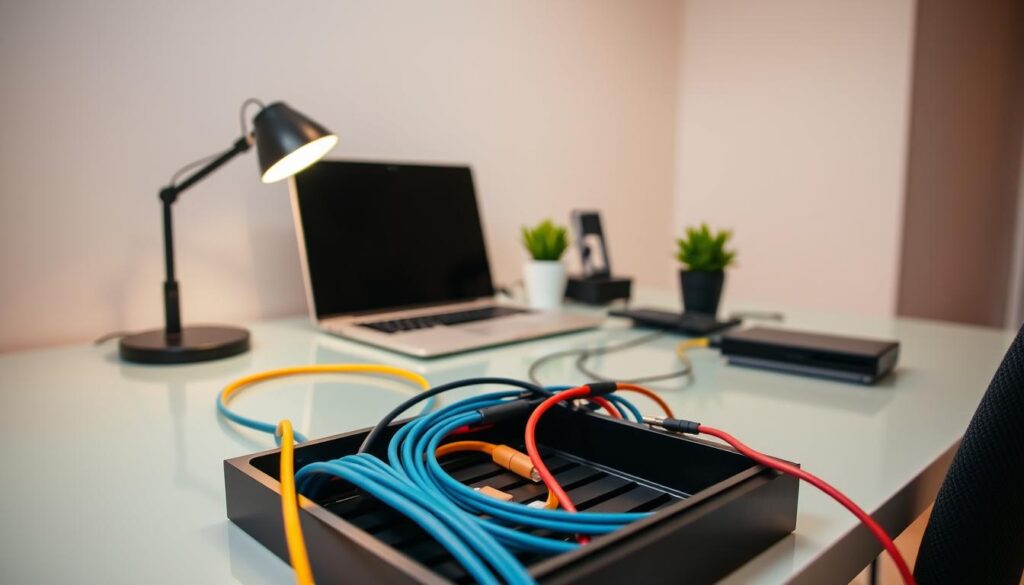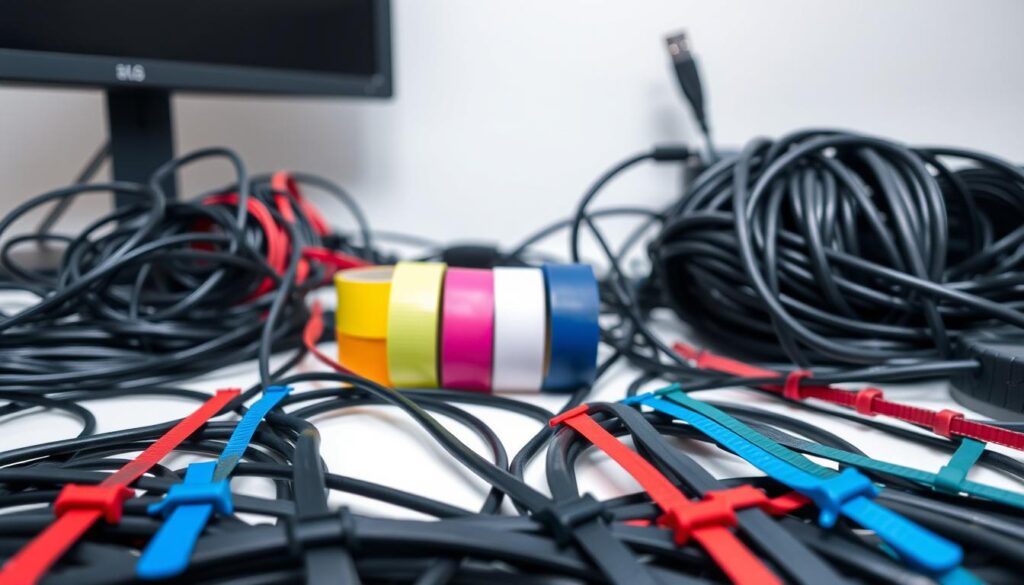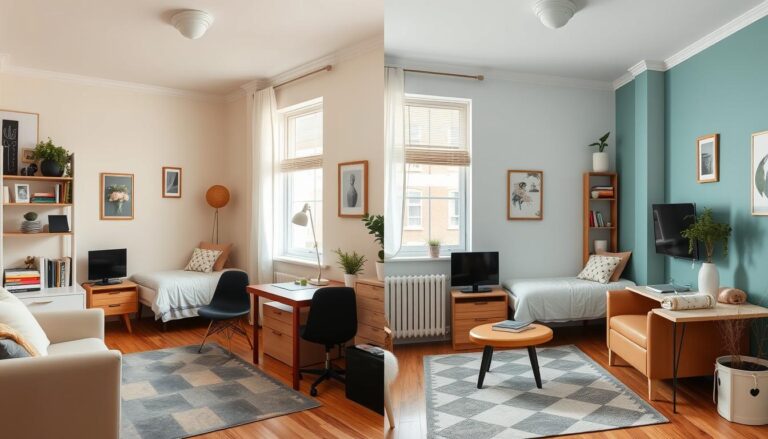DIY cable management hacks for your desk setup
Tired of cluttered student dorms? Try these DIY cable management for student dorms hacks to keep your study space organized and improve productivity.
A clean workspace isn’t just about aesthetics—it’s about functionality. Tangled wires under your desk can turn a productive area into a frustrating maze. With more devices like monitors, laptops, and chargers crowding modern setups, keeping cords under control is essential.

You don’t need expensive tools to fix this. Simple, budget-friendly strategies can hide cables and create a sleek look. For example, adhesive clips or binder clips repurposed as wire holders cost almost nothing. Even small changes, like grouping cords with Velcro straps, make a big difference.
Safety matters too. Loose wires can trip you or damage devices over time. Organized setups reduce these risks while making it easier to find what you need. This saves time and keeps your focus where it belongs: on your work.
Ready to transform your space? The tips ahead will show you how to effortlessly manage cords using items you already own. Let’s turn that chaotic desk into a streamlined hub for productivity.
Key Takeaways
- Messy wires harm productivity and pose safety risks.
- Affordable tools like adhesive clips simplify organizing.
- Grouping cords prevents tangling and extends their lifespan.
- A tidy workspace improves focus and efficiency.
- Most solutions require minimal time and everyday items.
Introduction to DIY Cable Management
Disorganized cables do more than create visual chaos—they pose real risks. Modern desks often host multiple electronics, from laptops to chargers, creating a jungle of cords. Left unchecked, this clutter becomes a safety hazard and productivity drain.
Understanding the Need for Streamlined Setups
Tripping over loose wires isn’t just inconvenient. Research shows cluttered spaces increase stress and reduce focus by 15%. A Princeton University study found visual distractions make it harder for the brain to process information efficiently.
What Else Would You Like to Know?
Choose below:
Tangled cords also wear out faster. Frayed insulation exposes live wires, creating fire risks in tight spaces. One report notes damaged power strips cause 3,300 U.S. home fires annually.
Benefits of a Minimalist Workspace
Neatly arranged electronics create a professional look for virtual meetings. You’ll spend less time untangling cords and more time completing tasks. A structured system also:
- Reduces accidental unplugging during important work
- Makes cleaning easier by eliminating dust traps
- Extends device lifespan by preventing bent connectors
“Orderly environments help people adhere to healthy habits and make better choices,” states Dr. Libby Sander, workplace psychology expert.
Transforming Your Student Dorm with DIY Cable Management for Student Dorms
Compact living spaces demand smart organization strategies to maintain both functionality and harmony. Shared rooms and tight quarters amplify the risks of tangled cords, from tripping hazards to strained roommate dynamics.
Maximizing Limited Space
Vertical storage transforms unused wall areas into practical zones. Adhesive hooks hold chargers near beds, while under-desk baskets hide power strips. Removable clips keep cords elevated, freeing floor space for movement.
Multi-device setups thrive with labeled extensions. Color-coded wraps distinguish laptop chargers from gaming console wires. This prevents accidental unplugging during study sessions or streaming marathons.
Boosting Productivity and Safety
Fire codes in campus housing restrict overloaded outlets. Grouping devices on surge protectors with visible airflow reduces overheating risks. Clear pathways prevent falls during late-night study breaks.
Neatly routed wires create mental clarity. A 2022 Cornell University survey found 68% of students focus better in organized environments. Quick-access ports also save time between classes and group projects.
“Temporary doesn’t mean careless – damage-free solutions protect both walls and security deposits,” advises campus housing coordinator Mark Teller.
Budget-Friendly Hacks Using Everyday Items
Everyday objects hold hidden potential for transforming cluttered spaces. With a little creativity, items destined for recycling bins can become functional organizers. Best of all, these methods cost almost nothing while reducing waste.
Repurposing Cardboard and Paper Products
Cardboard tubes from paper towels make ideal cord holders. Cut them into shorter lengths, decorate with washi tape, and slide charging bricks inside. For larger setups, flatten boxes to create custom dividers inside drawers.
Empty toilet paper rolls work as temporary sleeves for coiled wires. Label them with markers to identify phone chargers or laptop cords. Stack vertically in a shoebox for instant drawer organization.
Building Smart Storage on a Budget
Plastic food containers with lids double as weatherproof outdoor cable boxes. Use binder clips to secure wires to desk edges, or stitch old socks into stretchy cord covers. A repainted cereal box becomes a chic desktop tray for frequently used items.
| Material | Use Case | Benefit |
|---|---|---|
| Cardboard tubes | Charger storage | Prevents tangling |
| Toilet paper stands | Headset hangers | Saves desk space |
| Plastic containers | Power strip housing | Reduces dust buildup |
These solutions keep workspaces tidy while supporting eco-friendly habits. As sustainability expert Lena Jones notes: “Reimagining household items cuts clutter and consumption simultaneously.” Personalize projects with acrylic paints or contact paper to match your room’s style.
Utilizing Cable Ties, Velcro, and Cable Sleeves
Tangled cords turn productive spaces into frustration zones—but simple solutions exist. Three tools dominate efficient bundle organization: reusable fasteners, adjustable straps, and protective covers. Each offers distinct advantages depending on your setup’s flexibility needs.

Simple Tools for Bundle Management
Plastic ties provide permanent security for stationary devices like desktop computers. However, cutting them risks damaging wires during upgrades. For dynamic environments, Velcro straps allow endless adjustments without scissors. Their hook-and-loop design grips firmly yet releases smoothly when rearranging monitors or speakers.
Expandable sleeves merge protection with style. Nylon mesh versions suit home offices, while leather-look options elevate conference rooms. Measure your longest cord cluster before trimming sleeves to size—leave an extra inch for movement. Pro tip: Slide a bread bag clip onto loose ends to prevent slippage.
- Color-code straps: blue for audio gear, red for power strips
- Use wider Velcro strips for heavy-duty printer cords
- Twist ties temporarily group holiday lighting strands
| Tool | Best For | Lifespan |
|---|---|---|
| Cable ties | Permanent setups | Single use |
| Velcro straps | Frequent changes | 2+ years |
| Sleeves | Aesthetic protection | 5+ years |
“Reusable fasteners reduce waste while accommodating tech upgrades,” notes organizer Marie Kondo. “They respect both your space and the environment.”
Pair these tools with labeled ports on power strips. This combination creates systems where every cord has a clear purpose—and place.
Creating Custom Cable Management Boxes and Trays
Hidden storage solutions turn cluttered corners into organized hubs. By repurposing common containers, you can create discreet homes for chargers and power strips while maintaining easy access.
DIY Solutions for Concealing Chargers and Power Strips
Start with a sturdy container like a shoebox or plastic bin. Use a marker to outline entry points for cords on one side. Cut clean holes with a craft knife or drill, leaving enough space for thick plugs. Label each slot with washi tape to identify phone chargers, laptop adapters, or gaming gear.
Ensure proper airflow by leaving the box lid slightly open or adding ventilation gaps. Place surge protectors inside to centralize connections. For fire safety, avoid stacking items on top and keep the box away from heat sources.
Under-Desk Cable Baskets as a Practical Option
Mount wire baskets or plastic gutters beneath your workspace using removable adhesive hooks. Thread cords through the basket’s openings, letting excess length coil neatly inside. This keeps floor areas clear while allowing quick adjustments.
| Material | Best Use | Installation Time |
|---|---|---|
| Plastic gutter | Heavy-duty setups | 10 minutes |
| Wire basket | Quick-access devices | 5 minutes |
| Fabric bin | Lightweight items | 3 minutes |
“Always test adhesive strength before loading baskets—some surfaces need extra mounting strips,” advises home organization expert Emily Carter.
For temporary spaces, use tension rods to suspend baskets without adhesives. Color-code cords with stickers to match their labeled ports, creating a system that’s both functional and visually streamlined.
Hiding Wires Along Walls and Behind Furniture
Clearing floor space starts with strategic placement of electronics connections. Walls and furniture edges offer ideal pathways to keep cords invisible while maintaining easy access. This approach reduces tripping hazards and creates a polished aesthetic in any room.
Using Adhesive Clips and Command Hooks
Adhesive clips create clean lines along baseboards or molding. Space them 12-18 inches apart for optimal support without overcrowding. Position thicker cords near corners where they’re less noticeable.
Command hooks provide flexibility for temporary setups. Choose medium-sized hooks to hold multiple wires or bulky adapters. Press firmly for 30 seconds during installation to ensure strong adhesion. For painted surfaces, test a small area first to prevent peeling.
| Solution | Best Use | Removal Tip |
|---|---|---|
| Adhesive clips | Straight wall paths | Twist gently sideways |
| Command hooks | Behind furniture | Pull stretch tab downward |
| Cable sleeves | Multi-wire bundles | Cut with fabric scissors |
Match clip colors to your wall paint using acrylic markers. Light gray blends with most dorm room palettes, while white suits trim work. For textured surfaces, use clear silicone hooks that grip uneven finishes.
“Adhesive solutions should leave spaces as pristine as they found them,” says organizing consultant Rachel Hoffman. “Proper removal preserves surfaces for future tenants.”
Route cords through desk grommets before securing them to furniture backs with hook-and-loop strips. This dual approach keeps connections tidy and accessible for quick adjustments.
Innovative Techniques for a Sleek Cable Setup
Upgrade your workspace with solutions that blend practicality and visual appeal. Simple additions like vibrant accents or strategic placement tools can elevate both functionality and style.
Color-Coded Threads and Decorative Clips
Swap plain ties for colorful threads to wrap cord bundles. This method adds personality while making it easier to identify specific wires. Match thread hues to your room’s palette or assign unique shades to different devices.
Binder clips offer instant desk-edge control. Attach them to work surfaces and thread cords through the metal arms. This keeps chargers within reach but off the floor, maintaining a polished look.
Attaching Cables Neatly to Walls and Desk Edges
Adhesive clips along walls create invisible pathways for wires. Position them near baseboards or behind furniture to hide clusters. For desks, use low-profile holders that grip cords without damaging surfaces.
Rotate clips every few years to maintain adhesion strength. Combine with labeled ports on power strips for a system that’s both tidy and intuitive. Small changes today prevent clutter buildup tomorrow.
FAQ
How can I manage messy cords in a small dorm room?
What’s a cheap way to hide chargers and power strips?
How do I prevent tripping hazards from loose wires?
Can I organize cables without buying specialized tools?
How do color-coded threads improve setups?
What’s the best way to handle multiple devices?
The Best Colors to Make Your Student Apartment Feel Bigger
» See exclusive tips for your home








